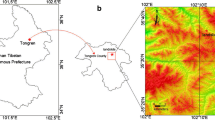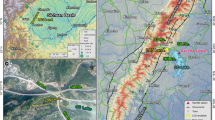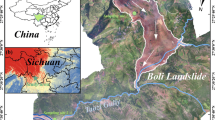Abstract
A large-scale loess landslide occurred in Xiaozhuang Village, Changjiahe Town, Tongwei County, Gansu, at approximately 11:00 am on September 14, 2019. A volume of 774 × 104 m3 of a historical sliding mass was reactivated by rainfall and slipped down along a weak interface. The sliding mass accumulated in the valley of the Kushui River, blocking the channel for a distance of ~ 1000 m and destroying several roads and the Yangpo Bridge. This landslide is a typical case of rainfall-induced revival of a historical seismic landslide in the loess region of Northwest China. On the basis of site investigation, Google satellite image, unmanned aerial vehicle photography, and numerical simulation, the deformation and failure characteristics of this landslide are described in detail, and the possible inducing factors and failure mechanism are preliminarily assessed. The Tongwei earthquake in 1718 and the Haiyuan earthquake in 1920 caused the slope to slide multiple times in history. Due to continuous rainfall, the existing softened layer (previous sliding surface) was highly saturated due to the perched water on the top of the relatively impervious mudstone and formed the critical weak zone. Therefore, previous sliding mass in the lower and middle slope was reactivated along the softened layer on September 14, 2019. We suggest that the perched water mainly came from the dominant seepage channels such as sinkholes and underground rivers. In addition, sinkholes on the previous sliding body are the key factors controlling the boundary of the landslide. The movement of the landslide lasted for 12 h, and the main landslide lasted for only 60 s, with a runout distance of 60 m and an average velocity of 5 m/h. Study of the formation conditions and failure mechanism of the Changhe landslide is of great significance for the early identification and risk prevention of this kind of landslide in the loess region of Northwest China.


















Similar content being viewed by others
Abbreviations
- W:
-
Water content
- ρ:
-
Density
- Gs:
-
Specific gravity
- e:
-
Void ratio
- PL:
-
Plastic limit
- LL:
-
Liquid limit
- PI:
-
Plasticity index
- cq:
-
Consolidated quick shear test
- C:
-
Cohesion
- σt :
-
Tensile strength
- φ:
-
Internal friction angle
- E:
-
Elasticity modulus
- Es:
-
Compression modulus
- μ:
-
Poisson’s ratio
References
Burchfiel BC, Zhang PZ, Wang YP, Zhang WQ, Song FM, Deng QD, Peter M, Leigh R (1991) Geology of the Haiyuan fault zone, Ningxia-Hui autonomous region, China, and its relation to the evolution of the northeastern margin of the Tibetan Plateau[J]. Tectonics 10(6):1091–1110. https://doi.org/10.1029/90TC02685
Chen T, Zhang PZ, Liu J, Chuan YL, Zhi KR, Kenneth WH (2014) Quantitative study of tectonic geomorphology along Haiyuan fault based on airborne LiDAR [J]. Chin Sci Bull 59(20):2396–2409. https://doi.org/10.1007/s11434-014-0199-4
Fan X, Scaringi G, Korup O, West AJ, van Westen CJ, Tanyas H, Hovius N, Hales TC, Jibson RW, Allstadt KE, Zhang L, Evans SG, Xu C, Li G, Pei X, Xu Q, Huang R (2019) Earthquake-induced chains of geologic hazards: patterns, mechanisms, and impacts. Rev Geophys 57:421–503. https://doi.org/10.1029/2018rg000626
Hu XD, Bian WQ (2009) Investigation and division report of geological hazards in Tongwei County, Gansu Province [R]. Geological Environmental Monitoring Institute of Gansu Province
Lanzhou Earthquake Research Institute of China Earthquake Administration, Ningxia Seismological Bureau (1980) The 1920 Haiyuan earthquake [M]. Seismological Press, Beijing
Peng D, Yang S, Li XB (2017) Distribution and mechanism of loess landslides induced by earthquake in Tongwei, Gansu Province [J]. Chin J Geol Hazard Control 28(03):31–38 (in Chinese)
Peng J, Wang S, Wang Q, Zhuang J, Huang W, Zhu X, Leng Y, Ma P (2019) Distribution and genetic types of loess landslides in China. J Asian Earth Sci 170:329–350. https://doi.org/10.1016/j.jseaes.2018.11.015
People’s Government of Tongwei County (2020) Geography Transportation [EB/OL]. http://www.tongwei.gov.cn/col/col6820/index.html. Accessed 27 March 2020
Shi RH (2013) Formation and evolution mechanism of the loess-red beds interface landslide [D]. Lanzhou University, Lanzhou
Sun P, Li R, Jiang H, Igwe O, Shi J (2017) Earthquake-triggered landslides by the 1718 Tongwei earthquake in Gansu province, Northwest China [J]. Bull Eng Geol Environ 76:1281–1295. https://doi.org/10.1007/s10064-016-0949-4
Sun P, Wang HJ, Han S, Li XB (2019) Institute of geomechanics conducted an on-site investigation into the “9–14” landslide disaster in Tongwei county, Gansu province [EB/OL]. http://www.cgs.gov.cn/gzdt/zsdw/201909/t20190925_494596.html, 2019-9-25. Accessed 28 Oct 2019
Tu XB, Kwong AKL, Dai FC, Tham LG, Min H (2009) Field monitoring of rainfall infiltration in a loess slope and analysis of failure mechanism of rainfall-induced landslides. Eng Geol 105:134–150. https://doi.org/10.1016/j.enggeo.2008.11.011
Wu Z, Ding B, Shao D (2019) Emergency investigation report on landslide disaster in Changhe town, Tongwei county, Dingxi city, Gansu province [R]. Geological disaster prevention engineering survey and design institute of Gansu Province
Xu L, Dai F, Tu X, Tham LG, Zhou Y, Iqbal J (2014) Landslides in a loess platform, North-west China. Landslides 11:993–1005. https://doi.org/10.1007/s10346-013-0445-x
Yuan ZH, Ni WK, Wang YH (2015) Property of tensile strength of unsaturated loess [J]. South-To-North Water Transfers Water Sci Technol 13(01):123–126 (in Chinese)
Zhang MS, Liu J (2009) Controlling factors of loess landslides in western China [J]. Environ Earth Sci 59(8):1671–1680. https://doi.org/10.1007/s12665-009-0149-7
Zhang C, Zhang M (2016) Development and Causes of group geological hazard in Tianshui City. Bull Soil Water Conserv 36(04):46–50+55 (in Chinese)
Zhou JX, Zhu CY, Zheng JM, Wang XH, Liu ZH (2002) Landslide disaster in the loess area of China. J For Res 13:157–161. https://doi.org/10.1007/bf02857244
Zhuang JQ, Peng JB, Xu C, Li Z, Densmore A, Milledge D, Iqbal J, Cui Y (2018) Distribution and characteristics of loess landslides triggered by the 1920 Haiyuan earthquake, northwest of china. Geomorphology 314:1–12. https://doi.org/10.1016/j.geomorph.2018.04.012
Acknowledgments
The authors especially appreciate the work of the editor and the useful comments provided by the reviewers. We thank Lucy Muir, PhD, from the Liwen Bianji, Edanz Editing China (www.liwenbianji.cn/ac), for editing the English text of a draft of this manuscript.
Funding
This work was supported by the National Natural Science Foundation of China (grant no. 41472296) and the China Geological Survey (grant no. DD20190717).
Author information
Authors and Affiliations
Corresponding author
Rights and permissions
About this article
Cite this article
Wang, H., Sun, P., Zhang, S. et al. Rainfall-induced landslide in loess area, Northwest China: a case study of the Changhe landslide on September 14, 2019, in Gansu Province. Landslides 17, 2145–2160 (2020). https://doi.org/10.1007/s10346-020-01460-0
Received:
Accepted:
Published:
Issue Date:
DOI: https://doi.org/10.1007/s10346-020-01460-0




